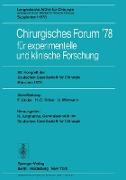- Start
- 95. Kongreß der Deutschen Gesellschaft für Chirurgie, München, 3. bis 6. Mai 1978
95. Kongreß der Deutschen Gesellschaft für Chirurgie, München, 3. bis 6. Mai 1978
Angebote / Angebote:
1. Nach Magenresektion oder Vagotomie mit Pyloroplastik findet sich ein gesteigerter Reflux von Gallensäuren und Lysolecithin in den Magen. 2. Die höchsten Reflux-Werte bestehen beim retrocolischen B-II (short loop) , etwa gleich große beim B-I (ohne wesentlichen Un terschied in den einzelnen Anastomosen-Formen) und beim anteco lischen B-II mit Braunscher Enterostomie. Auch hier sind die Re flux-Werte noch etwa 6 - 10-fach so hoch wie im Normal-Magen. Deutlich weniger Reflux haben die Vagotomien auch mit Pyloro plastik, die selektiv proximale Vagotomie hat keinen Reflux. 3. Isoperistaltische Jejunuminterponate reduzieren den Reflux in Abhängigkeit von der Länge des Interponats. Gleich wirkt eine Roux-en-Y-Gastrojejunostomie. 4. Nach Hemigastrektomie und Interposition von 25 cm isoperistal tischem Jejunum zwischen Magen und Duodenum finden sich im Tier experiment und beim Patienten normale Reflux-Werte im Resektions Magen. Summary 1. After gastrectomy or vagotomy with pyloroplasty the reflux of bile acids and lysolecithin increased. 2. The highest values of reflux were observed in the retrocolic (short loop) B-II anastomosis. The different types of B-I an trectomy and the antecolic B-II with Braun's enterostomy have each the same reflux, which is significantly lower than the re trocolic B~II. Even these types of gastrectomy have 6 - 10-fold elevated reflux values compared to the controls. After vagotomy with pyloroplasty the reflux was reduced to two or three times normal. After selective proximal vagotomy without pyloroplasty no reflux was observed.
Folgt in ca. 5 Arbeitstagen
